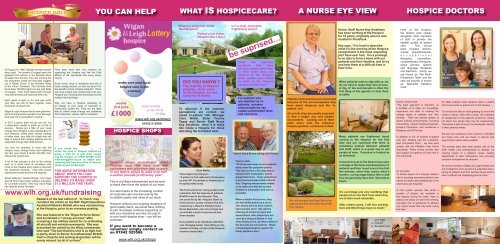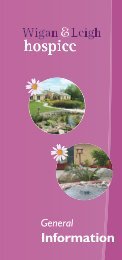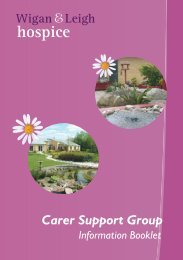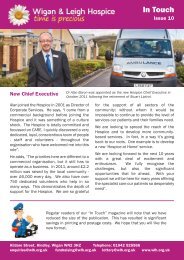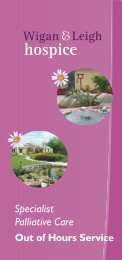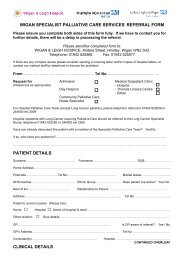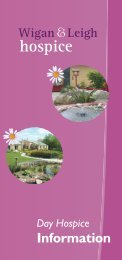Winter 2011 - Wigan & Leigh Hospice
Winter 2011 - Wigan & Leigh Hospice
Winter 2011 - Wigan & Leigh Hospice
Create successful ePaper yourself
Turn your PDF publications into a flip-book with our unique Google optimized e-Paper software.
HOSPICE GOLD<br />
YOU CAN HELP<br />
WHAT IS HOSPICECARE?<br />
A NURSE EYE VIEW<br />
HOSPICE DOCTORS<br />
On August 16, 1896, George Carmack dreamt<br />
about gold. He dreamt of nugget eyes that<br />
gleamed from salmon in the Klondike River<br />
20 steps from his feet. The next morning the<br />
old prospector pulled the first gold nuggets<br />
out of Rabbit Creek, in the Klondike Valley<br />
of the Yukon Territories. The Klondike Gold<br />
Rush drew 100,000 pilgrims to the gold fields<br />
of Canada. Their finds helped them through<br />
very difficult times and improved their lives.<br />
Each speck of gold on it’s own was worth<br />
very little, but lots of them together made<br />
thousands of people rich.<br />
<strong>Wigan</strong> & <strong>Leigh</strong> <strong>Hospice</strong> has its own goldmine -<br />
the kind and generous people of our Borough.<br />
One way this is exemplified, is below:-<br />
In <strong>2011</strong> a penny does not go very far, but<br />
a millionaire’s wealth is made up of lots of<br />
pennies. Simply put a little of your loose<br />
change into a <strong>Hospice</strong> ‘Loose Change Box’ on<br />
your fireplace, coffee table, kitchen worktop<br />
or office desk; your little bit of gold dust will<br />
help to ensure that <strong>Hospice</strong> patients can be<br />
supported through their difficult times.<br />
You may be surprised to learn that the<br />
<strong>Hospice</strong> loose change boxes and collecting<br />
tins last year raised a terrific £24,000, from<br />
little pieces of gold dust.<br />
A lot of that success is due to the untiring<br />
work of a small band of volunteers who<br />
come to the <strong>Hospice</strong> every week to deal with<br />
the donations received. They also ensure<br />
replacement boxes and tins are supplied.<br />
Sylvia Wilkinson, Sandra Brogan, Eric Howe<br />
and Alf Short have been stalwart volunteers<br />
for a number of years. New ‘boy’ David Page<br />
has recently joined ‘the team’.<br />
They each have their own reasons for<br />
supporting the <strong>Hospice</strong> and like the Gold<br />
Miners of old, appreciate that every penny<br />
counts.<br />
Every home, shop or workplace has bits of<br />
loose change around, so why not save it for<br />
the benefit of local <strong>Hospice</strong> patients? When<br />
you have a spare coin, simply drop it into your<br />
<strong>Hospice</strong> box, knowing how that simple act will<br />
multiply into big things.<br />
Why not have a <strong>Hospice</strong> collecting tin<br />
on display in your place of business or<br />
Community Centre etc. They are the ideal<br />
way to collect loose change and donations<br />
from customers, visitors, staff or members.<br />
If you would like t o<br />
enrich the lives of <strong>Hospice</strong> patients by<br />
giving a little bit of gold dust, simply<br />
ring the <strong>Hospice</strong> on 01942 525566, email<br />
fundraising@wlh.org.uk or obtain your<br />
collecting box from any of the 12 <strong>Hospice</strong><br />
shops around the Borough.<br />
FOR MORE INFORMATION<br />
ABOUT WAYS YOU CAN<br />
SUPPORT THE HOSPICE IN<br />
HELPING TO RAISE OVER<br />
£1.5 MILLION THIS YEAR...<br />
www.wlh.org.uk/fundraising<br />
Readers of the last edition of ‘In Touch’ may<br />
recollect the article on the RAF Flight Operations<br />
Assistant Natasha Brikett who was volunteering<br />
at the <strong>Hospice</strong>, prior to an overseas posting.<br />
She was featured in the ‘Royal Airforce News’<br />
and acclaimed a “runway success” after<br />
scooping a top military award for co-ordinating<br />
all aircraft and vehicle movements. She was<br />
presented her award by the Wing commander<br />
who said ”The fact that this Unit is so tight knit<br />
is partly down to Senior Arcraftswoman Birkett.<br />
Tash’s cheerful and smiling disposition will be<br />
sorely missed. by all of us here”.<br />
make sure your local<br />
hospice care is not<br />
a lottery<br />
weekly<br />
first prize<br />
£1000<br />
Lottery<br />
total weekly<br />
prize fund<br />
£1800<br />
www.wlh.org.uk/lottery<br />
01942 515566<br />
HOSPICE SHOPS<br />
<strong>Hospice</strong> shops co-ordinator Janet<br />
Fletcher says “We have over 400<br />
volunteers who give their time to work<br />
in our twelve shops to raise over halfa-million<br />
pounds profit every year!<br />
This is a brilliant achievement and we want<br />
to thank them from the bottom of our heart.<br />
It is also thanks to the increasing number<br />
of customers who are discovering the<br />
incredible quality and value of our stock.<br />
However without your ongoing donations of<br />
good quality items, we would have nothing<br />
to sell. So please continue supporting us<br />
with your donations and why not pop-in<br />
to your local <strong>Hospice</strong> shop – you will be<br />
surprised.<br />
If you want to become a<br />
volunteer simply contact us<br />
on 01942 525566.<br />
www.wlh.org.uk/shops<br />
What is it really like inside<br />
the <strong>Hospice</strong>?<br />
Patient’s live in the<br />
<strong>Hospice</strong> don’t they?<br />
Are there long wards of<br />
beds?<br />
DID YOU KNOW ?<br />
The majority of <strong>Hospice</strong><br />
patients, never come<br />
to the <strong>Hospice</strong>, but are<br />
cared for at home.<br />
To discover if the common<br />
perceptions are correct: we<br />
asked In-patient Unit Manager<br />
Clare Waller, Sister Yvonne<br />
Tague and Senior Staff Nurse<br />
Kay Smallman what it is really<br />
like inside a <strong>Hospice</strong> for those<br />
attending the In-Patient Unit...<br />
Clare Waller<br />
Clare begins by telling us –<br />
“A patient is first referred to the <strong>Hospice</strong><br />
by their GP, Consultant or Community or<br />
Hospital professional.<br />
The first surprise for many people is the<br />
realisation that the majority of patients<br />
NEVER come to the <strong>Hospice</strong>! They<br />
are cared for by the ‘<strong>Hospice</strong> Team’ at<br />
home and are usually visited in the first<br />
instance by a <strong>Hospice</strong> Palliative Care<br />
Nurse Specialist, who can arrange and<br />
co-ordinate a host of services as and<br />
when needed.<br />
Every patient is an individual, with their<br />
own changing needs. Everything we do,<br />
whether at home, or here at the <strong>Hospice</strong>,<br />
revolves around this.”<br />
Is it a drab, miserable,<br />
frightening place?<br />
be suprised...<br />
These are important<br />
questions that often<br />
concern people when they,<br />
or their loved ones, are<br />
referred to the <strong>Hospice</strong>.<br />
Some people even refuse<br />
to come to the <strong>Hospice</strong><br />
because of their fears!<br />
For patients who<br />
are admitted as inpatients,<br />
common<br />
misconceptions can<br />
create unwarranted fears<br />
and concerns.<br />
Patient David Brown talking with Yvonne<br />
Yvonne adds -<br />
“Of those who come as an in-patient,<br />
many come for symptom control.<br />
This may involve a few days stay to<br />
balance their medication, before<br />
going back home. Every patient has<br />
a personal care plan which reflects<br />
this. Ongoing assessments enable<br />
us to make sure that the correct<br />
treatment, medication and care is<br />
provided.<br />
When a patient first arrives, they<br />
are met at Reception by a nurse,<br />
who shows them to their modern,<br />
light and airy room. We start by<br />
listening to concerns, fears and<br />
expectations, after which they are<br />
seen by a <strong>Hospice</strong> Doctor. If and<br />
when family arrive, we inform them of<br />
the services we can provide. These<br />
include psychological support for<br />
family members also.”<br />
Patients and loved ones are concerned<br />
because of the pre-conceptions they<br />
have about <strong>Hospice</strong>s and the ‘inpatient’<br />
unit.<br />
On arrival, they are usually surprised<br />
to find a bright, airy and modern<br />
environment. Looking out of their<br />
patio doors onto the extensive<br />
<strong>Hospice</strong> gardens, a pleasure in itself.<br />
We ask people how they like to be<br />
addressed and the majority prefer<br />
first names.<br />
Senior Staff Nurse Kay Smallman<br />
has been working at the <strong>Hospice</strong><br />
for 16 years, originally when it was<br />
located in Poolstock.<br />
Kay says: “It is hard to describe<br />
what it’s like working at the <strong>Hospice</strong>,<br />
except that it is the most rewarding<br />
job I have ever had. It is a privilege<br />
to be able to form a bond with our<br />
patients and their families, and to try<br />
and help them at a difficult time in<br />
their lives.<br />
When patients come to stay with us, we<br />
do our best to make them feel at ease.<br />
A tray of tea and biscuits is often the<br />
first thing on the agenda, to help them<br />
to settle.<br />
Many patients are frightened about<br />
coming to the <strong>Hospice</strong> for the first<br />
time and are surprised that there is<br />
sometimes humour between patients<br />
and staff; which is a great way to put<br />
people at ease. Everyone is treated as<br />
an individual.<br />
I have lost count of the times I have seen<br />
a change in the faces and demeanour of<br />
patients and their loved ones in the first<br />
few minutes, when they realise what a<br />
modern, caring organisation this is and<br />
how we genuinely have their interests at<br />
heart.<br />
It’s a privilege and very humbling that<br />
people let us into their lives when they<br />
are at their most vulnerable.<br />
After sixteen years, I still love working<br />
here and little things mean so much.”<br />
part of the<br />
<strong>Hospice</strong><br />
Reception area<br />
Here at the <strong>Hospice</strong>,<br />
the doctors work closely<br />
alongside other members<br />
of staff to provide the<br />
highest quality of patient<br />
care. The clinical<br />
team includes doctors,<br />
nurses, physiotherapists,<br />
o c c u p a t i o n a l<br />
therapists, counsellors,<br />
complementary therapists,<br />
social workers, speech<br />
and language therapists<br />
and dieticians. Jointly, we<br />
are known as ‘The Multi-<br />
Disciplinary Team’ and the<br />
care we provide is known<br />
as ‘Specialist Palliative<br />
Care’.<br />
Doctor Joanne says,<br />
“The team approach is important, as<br />
it enables us to apply our knowledge,<br />
experience and skills in meeting the<br />
varying needs of patients and their<br />
families. There are several grades of<br />
doctor working at the <strong>Hospice</strong> including<br />
Consultants, a Senior <strong>Hospice</strong> Physician,<br />
<strong>Hospice</strong> Physicians, and sometimes a<br />
Registrar and GP trainee.<br />
In addition to the 12 bedded In-patient<br />
unit, Day <strong>Hospice</strong> and the consultantlead<br />
Out-patient Clinic; we also work<br />
closely with the Palliative Care Nurse<br />
Specialists. These nurses provide care<br />
and support for patients at home and in<br />
the community.<br />
Dr Jen adds<br />
“A further aspect of a <strong>Hospice</strong> doctor’s<br />
role is providing specialist palliative care<br />
advice to health care professionals in the<br />
community and hospitals.”<br />
A rota system ensures that whilst a<br />
number of doctors are available in<br />
the <strong>Hospice</strong> during the week, there is<br />
always one doctor on-call in the evening,<br />
overnight and at weekends to address<br />
any urgent issues that may arise during<br />
this time.”<br />
Dr Joanne<br />
Bullen<br />
Dr Cathy Higgins<br />
Dr Jen<br />
Waddell<br />
Dr Cathy explains what happens when a patient<br />
first arrives at the In-patient Unit of the <strong>Hospice</strong>...<br />
“On arrival and after an initial greeting by one of the<br />
nurses; a doctor, often with a nurse, will undertake<br />
an assessment of the patient’s symptoms, finding<br />
out about any issues they may be experiencing.<br />
This allows a plan of care to be developed, tailored<br />
to their personal needs.<br />
We are very conscious of the concerns of families<br />
and loved ones and are happy to discuss and<br />
support their needs where possible.<br />
The medical team then work closely with all the<br />
other health care professionals to maintain an<br />
ongoing review of a patient’s needs; making<br />
adjustments to their medications and providing<br />
symptom management as required.<br />
As doctors working in <strong>Wigan</strong> and <strong>Leigh</strong> <strong>Hospice</strong> we<br />
are privileged to work as part of a supportive team,<br />
caring for patients and their families during what is<br />
often a difficult and challenging time for them.”


